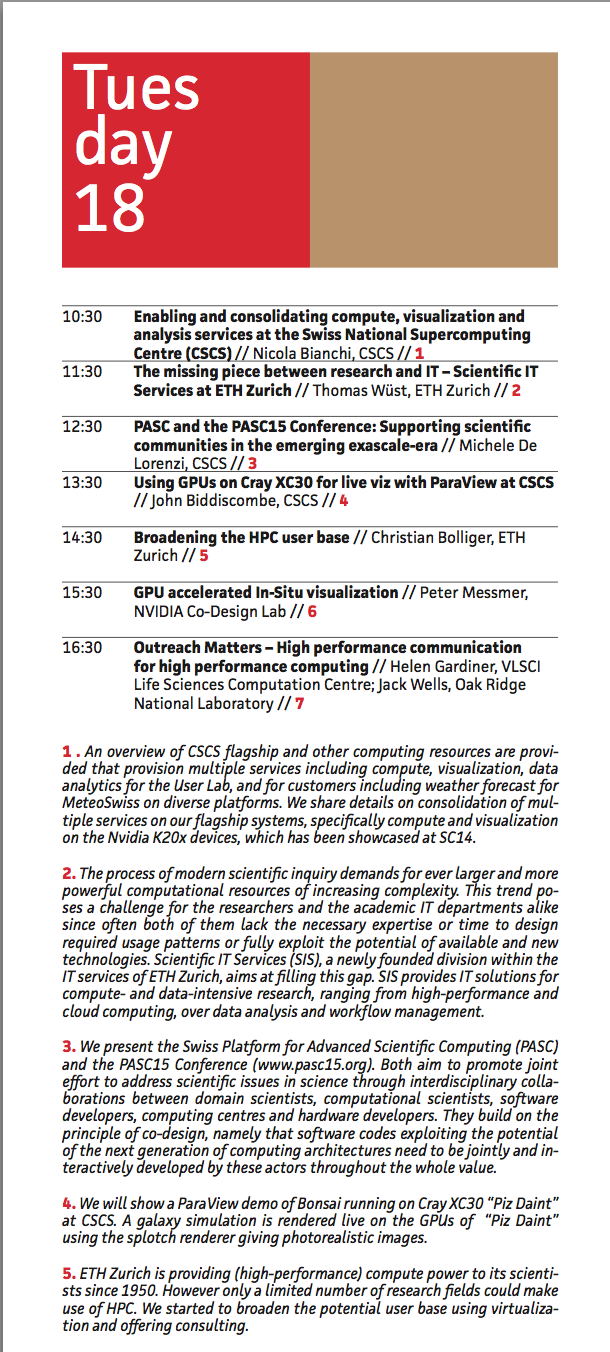Talks at booth 3756 on Tuesday 18.11.2014
The Swiss HPC community hpc-ch and CSCS invite you to visit the “Swiss House of HPC” at SC14 in New Orleans at booth 3756, where you can meet Swiss HPC specialists and scientists, and get the latest news about HPC and science in Switzerland, together with some Swiss coffee and chocolate.
Among the novelties, every hour you will have the opportunity to follow a talk that show the excellence of Switzerland in HPC and world-class research. By participating at one of the numerous talks you will receive a nice and original gift!
On Tuesday 18.11.2014 we will have the following talks:
10:30 Enabling and consolidating compute, visualisation and analysis services at the Swiss National Supercomputing Centre (CSCS) // Nicola Bianchi, CSCS // An overview of CSCS flagship and other computing resources are provided that provision multiple services including compute, visualization, data analytics for the User Lab, and for customers including weather forecast for MeteoSwiss on diverse platforms. We share details on consolidation of multiple services on our flagship systems, specifically compute and visualization on the Nvidia K20x devices, which has been showcased at SC14.
11:30 The missing piece between research and IT – Scientific IT Services at ETH Zurich // Thomas Wüst, ETH Zurich // The process of modern scientific inquiry demands for ever larger and more powerful computational resources of increasing complexity. This trend poses a challenge for the researchers and the academic IT departments alike since often both of them lack the necessary expertise or time to design required usage patterns or fully exploit the potential of available and new technologies. Scientific IT Services (SIS), a newly founded division within the IT services of ETH Zurich, aims at filling this gap. SIS provides IT solutions for compute- and data-intensive research, ranging from high-performance and cloud computing, over data analysis and workflow management.
12:30 PASC and the PASC15 Conference: Supporting scientific communities in the emerging exascale-era // Michele De Lorenzi, CSCS // We present the Swiss Platform for Advanced Scientific Computing (PASC) and the PASC15 Conference (www.pasc15.org). Both aim to promote joint effort to address scientific issues in science through interdisciplinary collaborations between domain scientists, computational scientists, software developers, computing centres and hardware developers. They build on the principle of co-design, namely that software codes exploiting the potential of the next generation of computing architectures need to be jointly and interactively developed by these actors throughout the whole value.
13:30 Using GPUs on Cray XC30 for live viz with ParaView at CSCS // John Biddiscombe, CSCS // We will show a ParaView demo of Bonsai running on Cray XC30 “Piz Daint” at CSCS. A galaxy simulation is rendered live on the GPUs of “Piz Daint” using the splotch renderer giving photorealistic images.
14:30 Broadening the HPC user base // Christian Bolliger, ETH Zurich // ETH Zurich is providing (high-performance) compute power to its scientists since 1950. However only a limited number of research fields could make use of HPC. We started to broaden the potential user base using virtualization and offering consulting.
15:30 GPU accelerated In-Situ visualization // Peter Messmer, NVIDIA Co-Design Lab // In view of the massive amounts of data produced by upcoming systems, new workflows must be explored for storing and post-processing. One approach is to analyze data while it is being generated, allowing for a significant reduction of data to be stored. In addition, such in-situ analysis allows for more interactive workflow, enabling a more exploratory approach to simulations. GPU accelerated supercomputers offer the advantage of both providing leading edge performance for the numerical simulations, as well as high-performance features for accelerating visualization. We will present the steps necessary to enable rendering and compute capabilities and discuss some of the steps to efficiently analyze simulation data on the fly.
16:30 Outreach Matters – High performance communication for high performance computing // Helen Gardiner, VLSCI Life Sciences Computation Centre; Jack Wells, Oak Ridge National Laboratory // The key mission for an Outreach Team is to engage with a variety of publics (stakeholders) on a regular basis through a variety of communication strategies, tools and tactics. We will focus on how an outreach team manages stakeholder relations and will demonstrate the many ways in which “Outreach Matters”. This will be done with some case studies and plenty of time for discussion and best practice sharing among the participants in attendance.
To learn more please visit the website: www.hpc-ch.org and follow us @hpcch on Twitter.


